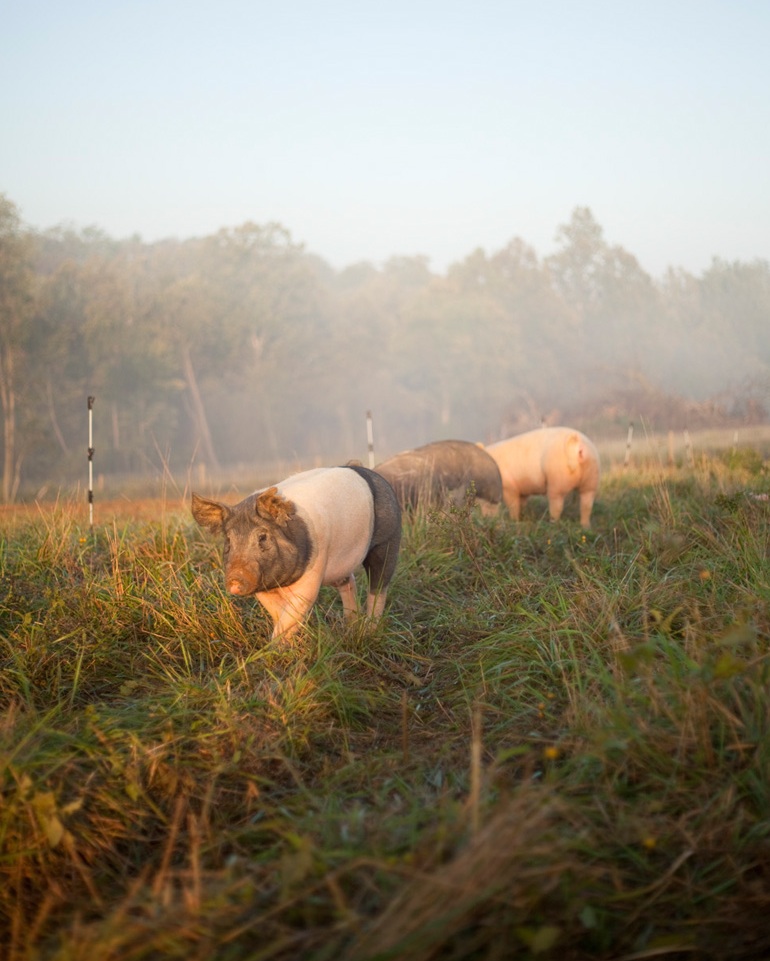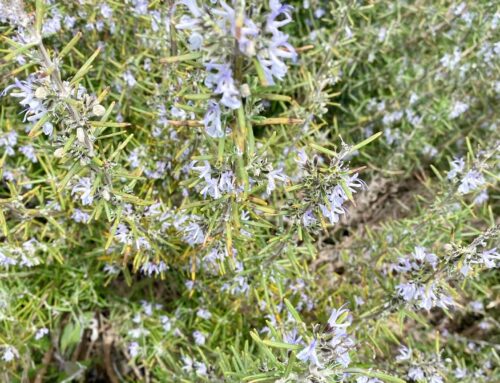Pasturing pigs isn’t a new idea. In fact, hogs have been raised in American meadows and woodlots since our country’s inception. Long before confinement barns, farrowing crates and manure lagoons became industry norms, pastured pigs were raised and finished on grass from coast to coast. From the A-frame pasture sleds of the Midwest to the oak-rich mountains of Appalachia, free-range pork has long been a brushstroke on our agricultural landscape.
My own grandfather, who considered swine an afterthought to his primary orchard and cattle business, took time to turn hogs loose amongst his apple trees from fall to spring. They gleaned fallen fruit, rooted up mouse nests, and fertilized the soil, all for pennies on the dollar. On a diversified farm, raising free-range hogs makes sense and cents.
Despite a rich tradition of pastured pig husbandry, a generation of experience and know-how was lost during the second half of the 20th century. As producers abandoned traditional outdoor systems and embraced confinement hog buildings, decades of hard-won wisdom quietly slipped through our fingers. When I began farming full-time in the mid 1990s, information about free-range pig systems at that time amounted to a few paragraphs in How To livestock books, or imaginative applications such as Polyface’s now famous Pigaerator Pork.
But I needed a system that accounted for seasonality and scaleability, combining modern efficiencies with old-fashioned husbandry practices. I wanted a better understanding of how pigs might fertilize depleted soils and interact with other livestock species, all the while producing mouth-watering bacon and hams. In hindsight, I’m not sure these restoration philosophies existed in one place. In an attempt to remedy this, here’s a list I wish had been available when I started out, knowledge I’ve gained from raising pastured stocker pigs for over fifteen years.
Note: This article is intended for successfully raising stockers on pasture. To learn more about raising piglets, butchering hogs and selling pork at farmers’ markets, check out my book, HERE.
Raising Pigs on Pasture: An Evolution
Version 1.0
Everyone has to start somewhere, and our farm is no different. During my first attempt at raising pastured pigs, I turned loose a group of twenty 50 pound piglets onto 15 acres. From the first moment they stepped off the trailer these pigs were in hog heaven, rooting the ground, grazing lush legumes and napping contentedly beneath our scattered shade trees. We gave them unrestricted access to feed, water and forage, and things went so well that a month later I purchased 20 more, then 20 more again. Before I knew it, I was the owner of 60 healthy, frolicking pigs running hither and yon, all different colors, sizes and personalities. Aside from checking on their daily feed and water, the pigs pretty much took care of themselves. I’ve dubbed this scenario “Pastured Pigs, version 1.0”.
It was all rainbows and butterflies for a few months, but the trouble began soon thereafter. Because pigs don’t sweat, they created large wallows to cool off. While at first I found this habit to be entertaining (and endearing), I commonly observed hogs drinking from this muddy, contaminated water. “Hogwash,” I said, and I was right. Widespread diarrhea quickly followed, accompanied by weight loss. The green water in these puddles looked as inviting as a neglected kiddie pool in late September.
Meanwhile, the pigs continued to root the pasture, constantly worrying the soil beyond its capacity to reestablish itself. After a few months of non-stop snout activity, my pasture effectively became a moonscape, pocked here and there with rank, algae-rimmed wallows. As a consequence, the pigs now relied almost exclusively on their grain ration, and manured straight onto bare, unvegetated ground. In effect, I had unintentionally allowed the pigs to create their own feedlot, the very thing I was seeking to avoid. I knew the system had to change, for the benefit of the soil as well as the hogs.
Version 2.0
In version 2.0, I’ve noticed a hot trend of raising hogs in woodlots and forests, and finishing the hogs on mast (nuts). While this sounds practical on paper, many of the same drawbacks found in version 1.0 also exist in 2.0 without careful oversight. Just like on open pasture, hogs will create a barren feed-lot landscape after a month or so if not rotated. This problem becomes compounded in a forest, however, because the delicate soil structure beneath the tree canopy is largely comprised of leaf litter, and not widely vegetated. Combined with an inclined gradient, this is a sure recipe for extreme erosion during a significant rainfall.
For version 2.0 to be successful (and it certainly can be), it’s my belief that acorn finishing should be an SEASONAL component of a free-range system, not a primary platform. The floor of a forest is armored with leaves for a reason; rain gently glazes off the durable litter, and water is distributed at an appropriate rate. Once this protection is heavily bioturbated by pig snouts, even a half-inch of rain can have disastrous effects.
Remember: gravity causes nutrients to flow DOWNhill. If we’re going to import nutrients UPhill—via pig manure—then we must do it strategically. This is accomplished by 1) patiently waiting for a seasonal nutfall to occur (mysteriously, sometimes this doesn’t happen for several years), 2) rotating the hogs through polywire forested alleys every week or two, and 3) getting them out again. When managed well, acorn-fed pork can be a tremendously efficient—and delicious—way to raise pigs.
Version 3.0
Several years ago at my farm Smith Meadows, we arrived at version 3.0. It’s a system intended to maximize soil building, multi-species grazing and authentic free-ranging for our pigs. Known as a ‘pivot system’, each field is envisioned like an old-fashion wagon wheel: a hub in the center, with spokes extending to the perimeter. In our case, the ‘wheel’ just happens to be a square field.
We start with 15 acres of permanent perimeter fence, then identify high ground as close to the center of the field as possible. This is our dedicated ‘sacrifice area,’ where our infrastructure is placed for precisely one year. It’s comprised of several large hog shelters (we use the evocatively named brand ‘Port-A-Hut’), and a fixed automatic waterer. High ground is important here because throughout the course of one year we commonly receive 35-40 inches of rainfall, and this water needs to drain away from the sacrifice area. Otherwise, the area can quickly become bogged down in muck.
Next, we pace off the perimeter, and divide it by 26. Fifty two weeks divided by twenty six means every two weeks the pigs receive a fresh rotation of one half acre. We typically stock 50 to 60 hogs at a time (of various sizes depending on what our breeders have available) and over the course of the year finish 250 hogs at roughly two hundred and sixty five pounds slaughter weight. In short, we’re growing 250 hogs a year on 15 acres, with next to no reseeding and very little labor. All the while, we our perennial pastures remain more or less intact for our sheep and cattle.
When provided with fresh pasture, pigs will actively graze. This reduces grain requirements, and distracts them from aggressive rooting. Of course, pigs WILL root a good bit of the pasture. But the key is to rotate them precisely every two weeks, and allow the pasture to rest and recover. As long as it is no longer disturbed, rooted pasture will mostly re-root itself and continue to grow. Between the hog manure fertilizer and the newly available seed bank, pasture recovers after a month or so with adequate rainfall (3/4 inch per week). If you live in a part of the country where this sort of rainfall is unlikely, then consider rotating once every week.
Gravity feeders are placed at the end of each run to encourage exercise, as well as manure dispersal. The hogs are fed a non-GMO blend of barley and wheat rated at 12% protein. When empty, these feeders are simply tipped onto their side and rolled to the new location. We use a single strand of polywire with a hot reading of 4.0 to control the hogs. The wire is strung about mid calf-height (or just below the knee), and step-in posts are spaced about 30 feet apart. A typical rotation takes 2 people about 45 minutes every two weeks.
For our waterer, we use an 85 gallon poly tank with a float in the bottom. A second float is installed in the top to control flow from the inlet hose. This is placed on a raised platform of pressure treated boards, and backfilled with gravel. The raised platform and gravel are intended to keep the splashed-out water from becoming a wallow. (The shelters provide them with plenty of shade and air flow to keep them cool in the summer). We use a hangman-type scaffolding to carry the piping over the hot wire and into the water tank. Otherwise, the pigs will chew the pipe to the point of breaking.

Our ‘sacrifice area’ from a distance. Notice how the pasture in the background looks grazeable for sheep and cattle. The pigs covered every inch of this ground months earlier.
The shelters are continually deep bedded with straw, which keeps the hogs warm on cold nights, and reduces floor moisture. However, as a result of rain shedding off the roofs, areas directly adjacent to the shelters are especially prone to puddling, followed by hog wallows. I can’t overemphasize how important it is to keep wallowing to a minimum, as it will reduce parasite loads and intestinal trouble down the road. Take my word for it: a sick pig is an unhappy pig. Good farmers raise happy pigs.
Lastly, to train our new hogs we create a miniature hub directly adjacent to the primary hub (visible on the left of the adjacent photo). This is a 32×32 foot area, cordoned off with cattle panels with a hot polytape running just inside the enclosure. The young pigs quickly learn about the boundaries without breaking out, knocking down field posts or destroying wire. We leave them here for 48 hours, and when turned out, we rarely have problems with them respecting the fence.
☀ ☀ ☀
Want to know more? Check out my books below, where I raise piglets, butcher my first hogs, and get chased up a tree by a 700 pound boar!















Hard to imagine where one (prospective farmer or interested consumer) would find a more thorough or thoughtful run down on sustainably, and ethically, raising pigs. Want to know where your food comes from ? Take the time to read this essay.
Very nice plan. I can see using this for free-range chickens as well. Watching the pasture rest and renew must be extremely satisfying. I love watching nature take steps to rejuvenate itself.
Forrest, Excellent job describing your system. Per my bias it is important to note that a structured breeding plan of genetics designed to thrive in the outdoor environment is key for success. Keep up the great management and outstanding prose!
Hi Forrest – can you expand on what you feed your pigs (ie. what ratio of barley to wheat? anything else other than grain and pasture?) I have pastured pigs in Nova Scotia – and am trying to fine tune my non-GMO home-made grain mixture – experimenting with fermenting and addition of (a wee bit of) whey. But would love to know what works for you – am finding it nearly impossible to find any “recipes” online that don’t rely on corn or soy or an abundance of whey/milk. Do you make any changes as the pigs age? Can you recommend an online source for feed information? Thanks so much. Loved your book by the way 😉
Hi Stephanie, seeing as a few years have passed I was wondering what you have learned about feed since then. I am in a similar mindset and like you can’t find much information about mixing feed without corn or soy. Would love any pieces of advice you’ve picked up! 🙂
Hi Forrest,
I have a 160 farm that has only had a few horses and some cattle on in for the last few years. It has maybe 60 acres of fairly flat pasture land and the rest in trees with a lot of underbrush. I am new to farming but have been sold on Salatin’s ideals. My wife recently died of cancer and I am convinced that the normal American diet is a major problem. I cannot afford cattle at this time. I would like to do chickens and pigs to start out with. I am not sure how to start. Should I use your mob grazing chicken or tractors? Should I put pigs in the woods as Joel does? I am 62 and have three young children still at home and we are excited about doing this. However, at my age I do not need to make a lot of mistakes. Besides I want my children to get the most out of learning how to do this with success. I also home-school. Another reason I desire to do this is to help my friends in Africa and South America. We tried traditional american farming with some of them and it has failed miserably. I am hoping this might become a training/resource center for them. Do you do consulting? Any assistance you may offer will be appreciated.
Love your blog.
Thanks for sharing your failures and successes. My husband & I have started raising pastured poultry following Joel’s model, but we want to add pigs. Although we have wooded area as Joel has demonstrated in his “pig in the Glen” model, we want to bring the pigs on the field to knock down a corn maze and prepare the ground for a cover crop without bringing out the tractors. Very little specific info available through my state extension service about pastured pigs, so we will use your experiences to develop our own approach.
Thanks again!!
Thank you for the article. We have a fairly large custom grazing operation and are in our second year of pasturing pigs. It’s been a learning curve, but we’re really enjoying it. We have heard mixed reviews of running chickens and goats with the pigs and think we’ll give it a try this Spring. Any ideas or recommendations for when we implement this? Also, when it’s time to catch the pigs, how do you do this with a cell center? Currently, we have a portable cage that we move around on pasture, so we can bribe them into it and lock them in when needed. Thanks again!
Loading is fairly easy, at least for us. We back a trailer up to the Port-A-Hut, and shepherd in the hogs with three people using hog ‘hurdles’ (panels). On a typical morning, it only takes about 20 minutes to get the job done.
[…] Pritchard has a great article on raising pigs on pasture and the lessons he has learned. That puts be a couple years ahead of my initial mistakes […]
[…] pork. I know it exists. Check out this terrific article about raising free-range pigs from Smith Meadows. Willow Creek Farms is known for humanely-raised, free-range […]
I’m a visual kinda guy – can you share a layout of what you describe in this article? I mean I think I get it but a diagram would seal it in my mind.
I have a small startup on six acres that we are slowing turning into a farm, installing fencing and making pastures as we can. Our property is long and narrow and I am trying to figure out the best way I can lay it out to rotate our animals thru so we dont have the same issues that you talk about above. For reference we have a young boar and a sow for breeding stock and intend to never have more than one litter (at most) on the property at any given time. So, I’m worried about the litter when they get close to the butchering weight and the effect it will have on the property. It seems to me that 10-14 150-200lb pigs can do alot of damage in a short amount of time. Other than the pigs, we have around 50 laying hens, a hand full of turkeys, and a handful of dairy goats.
Thanks
Takashi DeHart
Crete, IL
Forrest-
Thanks for taking the time to share your knowledge. I have just a couple follow-up questions:
1 Do the pigs have access to the hub and a paddock at all times, or are they turned out to the paddock in the morning, closed in, and then moved back to the hub at night?
2 Are you still happy with the watering system and wallow control in the ‘sacrifice’ zone?
3 How did you construct your perimeter fence — ie high-tensile, welded wire, a combination of both? Is it electrified?
Thanks again,
Aaron
Hi Aaron
1) Yes, 24/7 access to hub and fresh alley.
2) Yes
3) 4 strand high tensile, electrified.
Best,
Forrest
Forrest,
Would you be willing, at my expense, to come to our Nebraske farm and help us get set up correctly? We have an large family and 80-acre farm with the intent of raising animals the right way!!! I don’t believe in reinventing the wheel. We’ve read all of Salatin’s books, but having you come give us direction would be ideal.
I’d be willing, if you’re in no rush. I’m booked into January. Email me at info@smithfieldfarm.com, subject line: Nebraska Family Farm
Forrest,
Do you also rotate the sacrifice area? How crucial is it to have it on high ground? If one were to have a parcel in which “high ground” were virtually non existant, what would be the course of action you would reccommend?
[…] know this is not an exact science but the numbers help me). I got the hub and spoke idea from the Smiths Medows Farm blog but watered it down to my size. They do 26 half acre slices for 50-60 pigs moved every 2 […]
Nice article. Is it possible to do this without the grain rations and only giving kitchen scraps/old milk instead? I am not only interested in keeping costs down, but more importantly, if I ever have the chance to grow slowly and sell at the local farmer’s market, i want to be able to say “grain free (except kitchen scraps)”.
Any advice on my post above 4-9-2016?
Hi Sal—- I would not recommend kitchen scraps because of legitimate risk of trichinosis. Some folks plant vegetables in front of their rotation. Best wishes.
Hi Forrest-
Thank you for writing this very informative article. However, I’m just wondering:
Did you dedicat a 15 acre parcel just for pigs, or did you allow cattle to graze in the pasture after it has been rested? If so, how soon do you let cattle back onto a piece of pasture that has been rooted up, or would that be too rough on a parcel?
Also, you said you’re growing 250 hogs on 15 acres. How do you stagger the groups of pigs? (I.e. how many half acres of pasture do you keep between two groups).
Thanks again,
Brady
Hi Brady, we rotate the cattle through, uninterrupted, almost as though the hogs aren’t there. And we’re adding new stockers monthly. Best regards!
Does your book explain the above procedure in detail with pictures ?
Hi Forrest, I have a question. Umm correction, I have a lot of questions. We have 200 acres of heavy oak forest with 13 acres of grass,
My plan had been to do what you did with your hub but in the woods, soil is very sandy and fast draining.
Your Thoughts? Also just purchased Gaining Ground
Hi Jon, I recommend low stocking rates, with fast rotations for the first 2 years, then monitor the results. You’ll need time to hone your skills, and get experiential feedback from the soil, the animals, the vegetative regrowth. Plan to under-stock for at least those first two years to build your skill set, and rotate AT LEAST every 2 weeks. And thanks for buying the book! There’s a great profile on a woodland hog farmer, Chuck Talbott, in my followup Growing Tomorrow. Best regards, -Forrest
Have you used or considered using .. Geotex woven used for unpaved roads to increase stability .. less mud sinking .. in your dedicated sacrifice areas .. ?
Hello Forrest. Wondering about the containment spaces. Can the pigs free range on a large area, without fencing? How far will they travel? If no, what would we need to fence them in? Do they not burrow under the fencing?
is this rotation necessary for two pigs? We currently have around an acre and a half fenced, I was thinking of adding an electric line around the perimeter and free ranging them in the same area as the chicken and LGD. Would this work for only two hogs?
Yes, all animals should be rotated—irrespective of species. This system will work with as little as one hog. I don’t recommend it for fractional hogs, however.